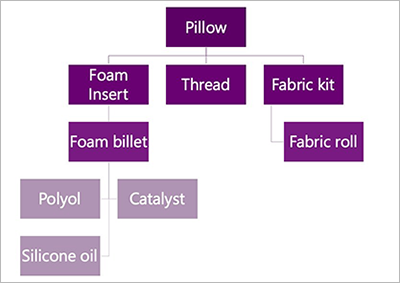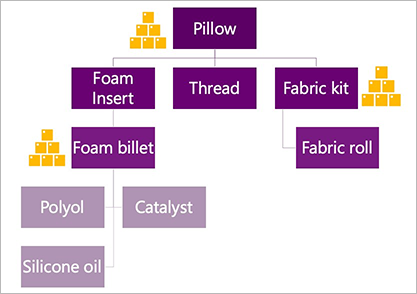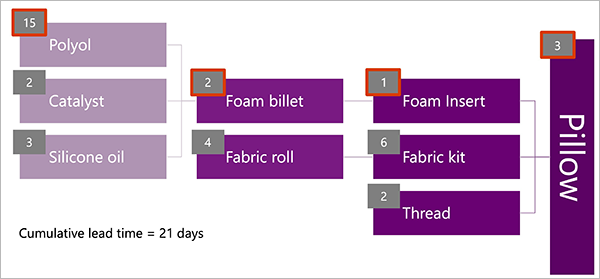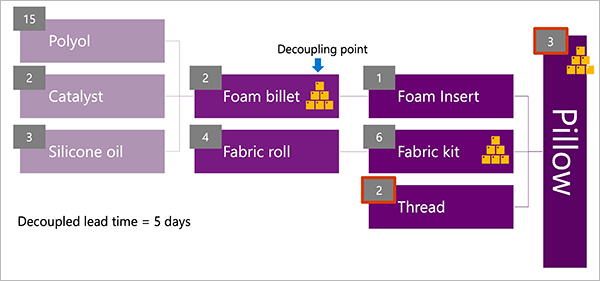Learn about Inventory Positioning in Microsoft Dynamics 365 Supply Chain Management

Effective inventory planning is pivotal for smooth supply chain operations, ensuring that goods reach consumers. Good management provides a better picture of stock levels, decreasing the chances of running out of stock or overstocking. This leads to improved customer satisfaction. Strategic inventory positioning involves identifying decoupling points in your supply chain, where you can build up inventory on hand. This tactic aims to reduce lead times and manage supply chain disturbances. By having inventory on hand, you can reduce the impact of the “bullwhip effect,” which occurs when small changes in demand at the retail level result in increasingly larger changes in demand as you move up the supply chain.
Inventory positioning for manufacturing
Here’s a scenario illustrating inventory positioning for a conventional pillow product. The pillow has a multi-level bill of materials (BOM), as shown in the following illustration.

Choose your decoupling points
In deciding the best buffer points, evaluate these elements for every component in the list:
- External variability
- Inventory leverage and flexibility
- Critical operation protection
- Customer tolerance time
- Sales order visibility horizon
- Market potential lead time
For instance, with the pillow, your primary buffer could be at the foam blocks due to:
- It’s difficult to source the materials that are used to make the foam billets, and availability is volatile. Therefore, the external variability criterion is met.
- The foam billets can be cut into many different shapes and sizes to create foam inserts for other products that you manufacture, in addition to the pillow. Therefore, the inventory leverage and flexibility criterion is met.
Your subsequent decoupling point could be at the fabric kit, the pre-cut material for pillows, given the single fabric cutting machine you possess. This satisfies the critical operation protection criterion.
Your final decoupling point may be the complete pillow, selected due to minimal customer wait-time for sales and a brief sales visibility horizon. This ensures sufficient stock for future orders and allows for premium pricing due to the reduced lead time, aligning with the market potential lead time criterion.
Based on this analysis, the following illustration shows what the pillow BOM will look like. Yellow inventory symbols highlight the decoupling points.

Calculate your decoupled lead time
This section shows how to calculate your new lead times after you’ve introduced decoupling points.
In the next image, which continues from the pillow example mentioned earlier, the time each part takes is displayed in gray boxes in the top left of every BOM piece. The components with a red border show the main contributors to the total time (which is the addition of the longest times from all levels of the BOM). If you’re starting fresh, this total time comes to 21 days

If you use the decoupling points you picked earlier, those specific items will always be available. This means their wait time becomes 0. Now, the pillow’s total wait time is shortened to five days: you spend two days getting the thread and another three making the pillow. We call this shorter wait time the ‘decoupled lead time’.

Strategic inventory positioning in a retail model
Retailers usually keep only completed products, so they don’t worry about BOMs. But they can apply DDMRP by organizing their stock and setting aside extra items according to where they store them in their supply chain.
There’s a picture next that gives an example: a company with a main supply center in Seattle and shops in Boston, Atlanta, and Portland.

You might decide that the transfer time to move a blanket product between the distribution center and the stores violates your customer tolerance time, because your customers expect the blanket to be in stock when they visit. In this case, you will set up a decoupling point for the blanket item at each of the three stores. Each store will have different buffer levels, based on its lead times, demand patterns, and so on.
Next Steps
If you are interested in learning more about how to use inventory planning in Microsoft Dynamics 365 for Supply Chain Management, contact us here to find out how we can help you grow your business. You can also email us at info@loganconsulting.com or call (312) 345-8817.

